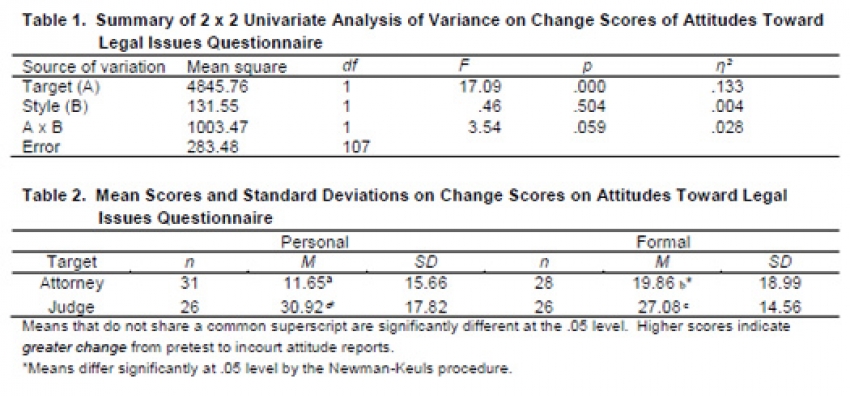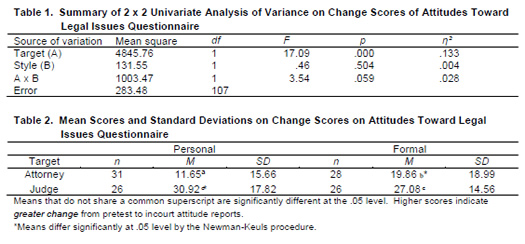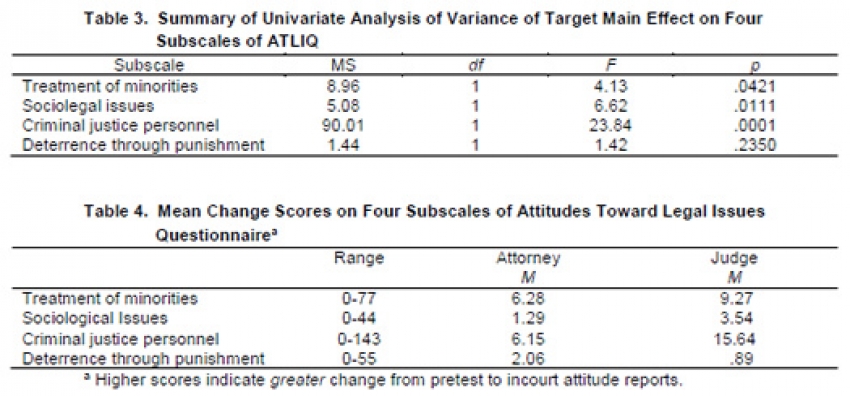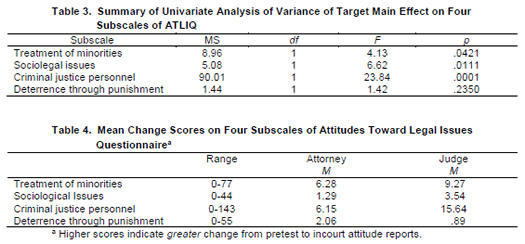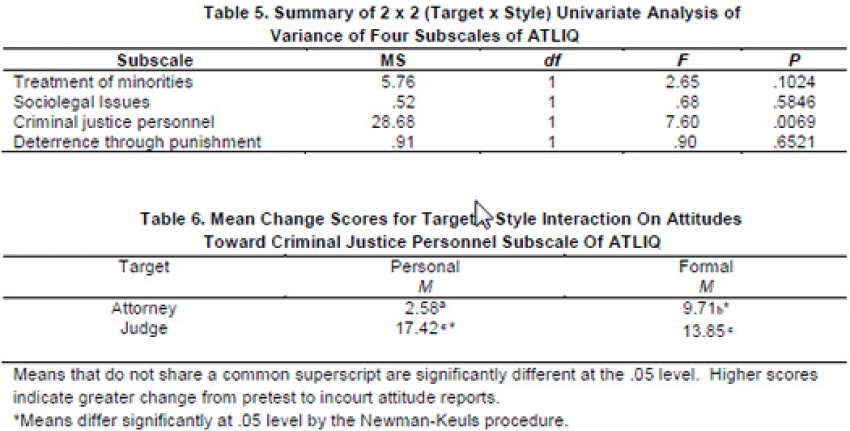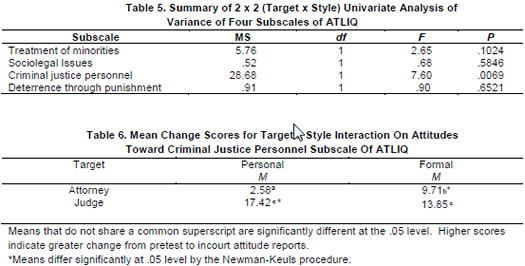Judge-Versus Attorney-Conducted Voir Dire
An Empirical Investigation of Juror Candor
Broeder (1965) found that potential jurors frequently distort their replies to questions posed during the voir dire. Considerable controversy has arisen over whether more honest, accurate information is elicited by a judge or by an attorney. The experiment manipulated two target (judge- versus attorney- conducted voir dire) and two interpersonal style variables (personal versus formal). The dependent measure was the consistency of subjects' attitude reports given at pretest and again verbally at court. One-hundredand- sixteen jury-eligible community residents participated. The results provide support for the hypothesis that attorneys are more effective than judges in eliciting candid self-disclosure from potential jurors. Subjects changed their answers almost twice as much when questioned by a judge as when interviewed by an attorney. It was suggested that a judge's presence evokes considerable pressure toward conformity to a set of perceived judicial standards among jurors, which is minimized during an attorney voir dire.
1. Introduction
The right to a fair and impartial jury of one's peers is a right guaranteed to each criminal defendant by the sixth and fourteenth amendments in the U.S. Constitution. One of the vehicles through which the court seeks to meet this obligation is a process called the voir dire. Voir dire, literally translated as ''to speak the truth'' (Gifis, 1975: p. 222), is the preliminary stage of jury selection during which perspective jurors are examined to determine their suitability to hear the case before court. The goal of this procedure is to excuse jurors failing to meet the criteria for jury service or holding biases or prejudices viewed as likely to interfere with their impartiality (Bush, 1976). Attorneys for either side may have a member of the jury panel (venire) removed by exercising a challenge for cause or a peremptory challenge. Attorneys exercise causal challenges when they can demonstrate that a juror (a) fails to meet statutory requirements for jury service, or (b) exhibits sufficient prejudice against one of the parties that the juror is unlikely to be capable of rendering a fair and impartial verdict. Peremptory challenges are made at the attorney's discretion and are generally reserved for when the attorney believes that a juror remains biased but this cannot be sufficiently demonstrated to have the juror removed for cause.
Clearly, prudent use of either type of challenge is contingent upon obtaining honest, accurate information from potential jurors regarding their background, attitudes, and beliefs (Bush, 1976).
According to federal and most state statutes, the questioning of potential jurors during the voir dire may be done by the judge, by the attorneys, or by some combination of the three.
The current practice in most federal courts, and in an increasing number of state courts, is one in which the judge conducts the questioning of potential jurors (Bermant & Shapard, 1978). Although counsel for both sides may submit questions, judges use their discretion regarding which, if any, of the submitted questions are posed to the jury.
This departure from attorney-conducted voir dire has created considerable controversy in the legal system. Those arguing for judge-conducted voir dire assert that a considerable amount of time and money is saved under such a system (Stanley, 1977). It is assumed that jurors are as candid, or even more so, when questions are posed by a judge rather than by an attorney. Levit, Nelson, Ball, and Chernick (1971) go so far as to suggest that the formality and gravity of the situation created by the judge's presence are likely to increase juror candor. They assert, without empirical support, that the respect elicited by the robed judge serves to enhance judges' effectiveness in obtaining truthful responses from jurors.
Several respected legal scholars (e.g., Babcock, 1975; Bonora & Krauss, 1979; Bush, 1976; Glass, 1977; Padawer-Singer, Singer, & Singer, 1974) dispute the assumption that the judge's active role leads to greater juror candor. Citing anecdotal and case data, they argue that the judge will be seen as an important authority figure, and as such, jurors will tend to be concerned about displeasing him or her. Such a concern is likely to cause jurors to be less than honest in their replies.
This has been an issue of considerable debate; however, no empirical studies available have systematically varied each condition (judge- versus attorney-conducted voir dire) and measured the quality and quantity of information elicited from prospective jurors.
Suggs and Sales (1981) aptly characterize the voir dire as a self-disclosure interview in which information is sought from potential jurors concerning their history, attitudes, and beliefs. Empirical investigations on self-disclosure have repeatedly found that individuals disclose more to (a) those from whom they receive moderate selfdisclosure (reciprocity effect), (b) those whom they like more, and (c) those whom they perceive as sharing equal status with themselves (status similarity) (Chelune, 1979).
Research has shown that a significant correlate of subject self-disclosure is the amount of self-disclosure he or she initially receives from a target (see, e.g., Ehrlich and Graeven, 1971; Jourard, 1959, 1969). Subjects exposed to a high self-disclosing confederate disclose at higher levels themselves within certain parameters. For example, Simonson (1976) paired subjects with interviewers who behaved in either a cold, aloof fashion or in a warm friendly manner, and who disclosed at one of three levels: personal disclosure, disclosure of demographic information, or no disclosure. This study found that subjects exposed to a warm interviewer who disclosed
demographic information (moderate disclosure) were the most effective in eliciting selfdisclosure from subjects. Not surprisingly, the cold aloof interviewers elicited a little or no self-disclosure, regardless of the intimacy level of their disclosure. These and other studies prompted Archer (1979) to conclude that the reciprocity effect is one of the most robust and reliable effects in social psychology.
Liking for the target of self-disclosure also influences the degree of subjects' return self-disclosure. Subjects disclose most to the targets who are most liked and disclose least to the targets who are least liked (Critelli, Rappoport, & Golding 1976; Jourard, 1959; Worthy, Gary, & Kahn, 1969).
Finally, similarity in status and authority are important to interviewees in selecting targets of self-disclosure. Slobin, Miller, and Porter, (1968) found that employees were more willing to disclose to other employees within their own hierarchical level rather than to more powerful superiors. Apparently, disclosure to a more powerful target is perceived to entail considerable risk, and subjects prefer not to reveal themselves to targets who hold substantial power. As Goodstein and Reinecker (1974) note, ''we selfdisclose to those who have already demonstrated that they will not punish our selfdisclosure and to those who have no capacity for punishing such behavior'' (p. 52).
In examining the courtroom behavior of attorneys and judges in light of the research on self-disclosure, a number of things become apparent. At the beginning of the voir dire, attorneys typically engage in moderate selfdisclosure to the panel, disclosing some personal information about themselves, their background, and their faith in the judicial system (Van Dyke, 1977). Manuals on courtroom tactics encourage such behavior (e.g. Bonora & Krauss, 1979; Jordan, 1981). Judges, however, purposely attempt to maintain a formal demeanor in their courtroom interactions to avoid compromising their role as arbitrator and typically do not offer personal disclosure to the panel.
Moreover, attorneys generally attempt to appear warm and friendly to jurors in order to win favorable consideration for their clients (Bonora & Krauss, 1979; Suggs & Sales, 1981). They expend considerable effort to gain jurors' positive regard and are in a much better position than judges to succeed. As Suggs and Sales (1981) assert, ''attorneysIhave and use the flexibility to interact with jurors in a more open and personal manner, thereby influencing perceived familiarity, liking and warmth'' (p. 253). On the other hand, many of the requirements of the judge's role are unlikely to promote4 liking. The judge, cloaked in a long black robe, sits elevated and apart from the rest of the courtroom, literally looking down upon the jurors. He or she is addressed as ''Your Honor,'' rather than with a more personal address.
Finally, judges and attorneys hold different levels of ascribed status in the courtroom. Although attorneys' social status may be higher than that of most jurors, there is less of a discrepancy between jurors and attorneys than between jurors and judges (Suggs & Sales, 1981).
As a function of their relative adherence to these respective roles, coupled with their typical courtroom behaviors, it seemed likely that jurors would perceive attorneys as more similar to themselves and report greater liking for them than for judges. These two factors, in conjunction with attorney self-disclosure (reciprocity), were predicted to interact such that attorneys would be more effective than judges in eliciting juror self-disclosure.
Finally, the present study sought a parsimonious explanation for the predicted efficacy of these three factors in facilitating self-disclosure. Fenigstein, Scheier, and Buss (1975) proposed that the degree of attention to the public aspect of the self is a mediator in the relationship between individuals' privately held attitudes and beliefs and their public expression of them. Essentially they suggest that the consistency (honesty) of individuals' self-disclosure is mediated by the degree to which they are focused on the public aspects of themselves.
Applying these hypotheses to the courtroom, it was expected that jurors who were interviewed by a judge would remain in states of relative heightened public selfawareness. Such a state would cause their self-reports of attitudes and beliefs to differ considerably from their privately held attitudes and beliefs. It was expected that individuals interacting with an attorney would show a reduction in their levels of public self-awareness. It seemed likely that the presence of the factors shown to facilitate selfdisclosure (reciprocity, liking, and similarity) would function to lower jurors' relative levels of public awareness by lessening their attention to the evaluative aspects of an interaction. Buss (1980) observed that attention to the public self decreases as liking and familiarity with a target increases. Lower levels of public self-awareness have been shown to be associated with greater consistency of attitude reports across situations (Froming, Walker, & Loypan, 1982; Scheier, 1980).
Consequently, this study empirically tested the efficacy of a judge-conducted versus an attorney-conducted voir dire in eliciting honest, accurate self-reports of attitudes and beliefs from potential juror (venirepersons). The study operationalized ''honesty'' as the degree of consistency between jurors' pretest attitude scores, obtained under conditions outlined by Petty and Cacioppo (1981), and their public attitude reports obtained while subjects were participating in the voir dire. Further, the interpersonal behavior of the judge and the attorney was varied to assess whether alterations in the characteristic interpersonal behavior of judges would enhance their effectiveness in eliciting information from venirepersons, if in fact, they were less successful than attorneys. Finally, the study was designed to be functionally similar to a real courtroom experience and used jury-eligible community residents in order to overcome the most salient criticisms of court-related research (see Kerr & Bray, 1982).
In sum, the current experiment assessed the effects of two target conditions (judge - versus attorney-conducted voir dire) and two interpersonal style conditions (personal versus formal) on attitude change scores, calculated based on the difference between subjects' attitude reports given at pretest and those given verbally in court. In addition, change scores on public self-awareness were similarly calculated based on scores obtained at two intervals in the voir dire.
Hypotheses1. Change scores for subjects in the attorney, personal voir dire condition were predicted to be significantly smaller than change scores for subjects in the judge, formal condition.
2. Change scores for subjects in the judge, personal voir dire condition were predicted to be smaller than change scores for subjects in the judge, formal voir dire condition.
3. Subjects in the attorney-conducted voir dire conditions were predicted to show greater consistency in their attitude reports from pretest to incourt than subjects in the judge conditions.
4. It was predicted that subjects who interacted with a target whose behavior included self-disclosure and other behaviors intended to influence liking (personal condition), would show greater consistency in their self-reports than would subjects who interacted with a target whose behavior was cool and aloof (formal condition).
5. It was predicted that subjects in the attorney, personal voir dire would show a greater decrease in self-awareness than subjects in the judge, formal condition.
* This article is based on the author's doctoral dissertation submitted to The University of Alabama under the direction of Stanley L. Brodsky. This study was supported by grant No. 83-IJ-CX-0020 from the National Institute of Justice, U.S. Department of Justice. Points of view or opinions stated in this article are those of the author and do not necessarily represent the official position or policies of the U.S. Department of Justice. The author wishes to extend sincere thanks to Stan Brodsky, Ron Rogers and Steve Prentice-Dunn for their generous donations of time and assistance on this project.
University of Alabama.
